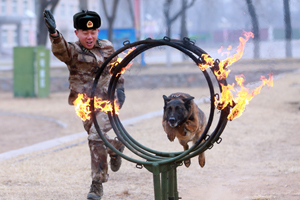Smog returns to North China
BEIJING - Smog will hit parts of northern and central China Tuesday, the Ministry of Environmental Protection warned Monday.
The smog will return to Beijing and Tianjin, as well as Hebei, Shanxi, Shandong and Henan provinces, and is expected to last until a cold front comes to the rescue around Thursday, according to the ministry.
However, the ministry said air pollution could return again Saturday, but hopefully disperse again next Tuesday as conditions improve.
Despite government efforts to fight pollution, outbreaks of smog have become increasingly common in northern China in winter where cold weather and the burning of coal combine to exacerbate the situation.
Severe smog triggered red alerts in more than 20 cities at the beginning of the new year, leaving a number of manufacturers to cut production, and heavily polluting vehicles banned from roads.
In environment inspections last year, the ministry said that a total of 720 people were detained and 6,454 held accountable for environment-related offences.
In 2016, the government declined 11 high-pollution and high-energy consuming projects, involving total investment of 97 billion yuan (about 14 billion U.S. dollars).
Partly due to such efforts, Chinese cities reported less PM2.5 pollution in 2016, with the average density of PM2.5 in 338 cities falling by 6 percent.
China is aiming for a 10 percent reduction in air emissions from 2012 levels by 2017 in cities at the prefecture level and above. Meanwhile, the PM 2.5 density in Beijing, Tianjin and Hebei Province should drop 25 percent.
The smog will return to Beijing and Tianjin, as well as Hebei, Shanxi, Shandong and Henan provinces, and is expected to last until a cold front comes to the rescue around Thursday, according to the ministry.
However, the ministry said air pollution could return again Saturday, but hopefully disperse again next Tuesday as conditions improve.
Despite government efforts to fight pollution, outbreaks of smog have become increasingly common in northern China in winter where cold weather and the burning of coal combine to exacerbate the situation.
Severe smog triggered red alerts in more than 20 cities at the beginning of the new year, leaving a number of manufacturers to cut production, and heavily polluting vehicles banned from roads.
In environment inspections last year, the ministry said that a total of 720 people were detained and 6,454 held accountable for environment-related offences.
In 2016, the government declined 11 high-pollution and high-energy consuming projects, involving total investment of 97 billion yuan (about 14 billion U.S. dollars).
Partly due to such efforts, Chinese cities reported less PM2.5 pollution in 2016, with the average density of PM2.5 in 338 cities falling by 6 percent.
China is aiming for a 10 percent reduction in air emissions from 2012 levels by 2017 in cities at the prefecture level and above. Meanwhile, the PM 2.5 density in Beijing, Tianjin and Hebei Province should drop 25 percent.


















